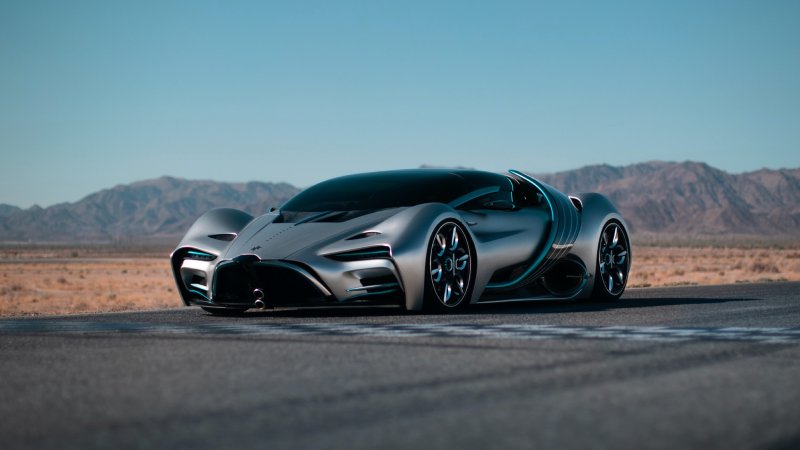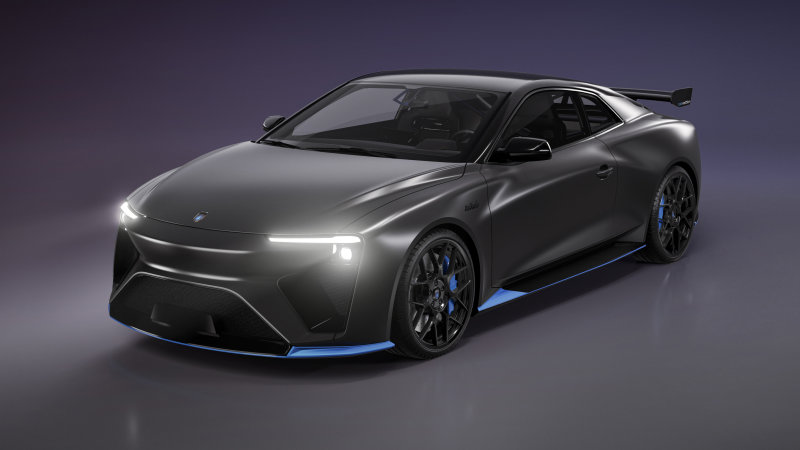Roland Gumpert launched his Apollo more than 10 years ago, eventually losing his fearsome coupe to insolvency and Consolidated Ideal TeamVentures. Gumpert, however, was working on more models, one of them called the Explosion, shown in Geneva in 2014. Based on looks and power specs, our best guess is that Gumpert took the Explosion with him into a new partnership with Chinese automaker Aiways, which owns the carmaker now known as Roland Gumpert, and slowly turned it into the Nathalie supercar meant for debut at this year’s ill-fated Geneva show. Gone is the 2.0-liter turbo four-cylinder with 420-horsepower. In its place, a methanol-fueled powertrain that combines a fuel cell, a buffer battery, and four electric motors. Combined capacity of methanol, fuel cell, and battery is 178 kWh, combined system output tallying 536 hp and more than 730 pound-feet of torque.
It starts with a 17.2-gallon tank that holds the methanol, which takes three minutes to fill. In a process that reverses the laboratory creation of methanol, the alcohol is heated to between 572 and 752 degrees Fahrenheit, separating the liquid into carbon dioxide and hydrogen. The hydrogen gets sent to a 15-kW fuel cell to produce electricity, which is not sent to the battery, but straight to the electric motors located at each wheel, those four motors coordinated by two, two-speed gearboxes. All that chicanery is said to propel the 14-foot-long coupe from standstill to 62 miles per hour in 2.5 seconds, on to a top speed of 190 miles per hour, and a range of 510 miles at 75 miles per hour. When driven in Eco mode, range extends to about 745 miles.
The Nathalie looks mild on the outside, like some JDM-only coupe found in Gran Turismo that spent a little time in the tuning shop getting a huge wing. Yet the Nathalie’s made of supercar build techniques — a chromoly tube chassis overlaid with a skin made of flax and carbon composites for light weight, plus a full FIA roll cage behind the cabin seats. The doors open in the scissor fashion Lamborghini has made famous. A McPherson front suspension and double wishbone rear handle the dynamism. The front brakes are enormous, and so are the rears. Thin lights front and rear, large intakes, and conspicuous ground effects complete the look. The Nathalie’s lines can be seen in another product from Aiways, the U6ion concept (traditional) electric crossover coupe also intended for debut in Geneva, both breathed on by Aiways lead designer Ken Okuyama, who penned the Ferrari Enzo and led Pininfarina design for a spell.
RG will build 500 of the Nathalie, which includes a small number of the First Edition example shown, with deliveries scheduled to begin next year. Each one will run €407,000 ($455,000 U.S.) before taxes. Where is an owner expected to get methanol if he doesn’t live near a race track or commercial depot? Gumpert said, “An overnight delivery service has been installed for the exclusive customer base for Germany, Austria, Switzerland and is currently being expanded throughout Europe. The North America and Middle East regions are also currently being developed.” What’s more, RG will pay for the methanol supply for the first year after delivery.
Related Video:


